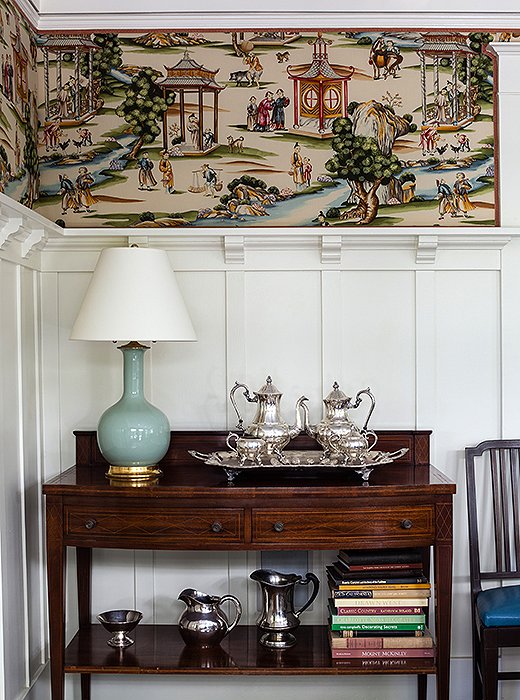Chinoiserie is an enduring interior design aesthetic and one of my favorite decorating styles. Porcelain blue & white jars, foo dogs, pagodas, garden seats and lacquered wood furniture are its most common motifs.
Whenever I think of the timeless Chinoiserie style, the quintessential tastemaker of our era Carolyne Roehm always comes to mind. I've followed Carolyne in her various homes over the years and in terms of interior design sensibility, Chinoiserie is always the star of the show. Read here about Carolyne Roehm's renovation of Chisolm House
Design Elements of Chinoiserie-Style
Pagodas - a turreted structure with severel eves, the pagoda that translates to place of worship, originated in East Asia particularly throughout the Buddhist community. Bringing pagodas to China they became part of classic Chinese architecture.
Dragons - Dating back to early Chinese Emperors Chinese dragons or East Asian dragons were revered for their mythic strength, sense of good luck and possessing auspicious powers. Dragons decorated furnishings, ceramics, silk screens, works of art as well as clothing.
Foo Dogs - Representing the eastern philosophy of ying & yang, foo dogs which are more formally known as Chinese Guardian Lions or Imperial Guardian Lions paired - male and female stood guard protecting Chinese palaces and temples. Today, still displayed in pairs their purpose is more decorative.
Lacquered Wood - The signature sheen of a lacquered piece of traditional Chinese furniture is achieved by hand applying several coats of tree sap and then often decorated with ornate images of scenery in jewel tones or gold leaf. The British furniture maker and interior design Thomas Chippendale in the mid 1700s was famous for his elegant hand carved fretwork and Chinese-inspired designs, particularly on cabinetry and seating.
Ceramics - The most enduring and readily recognizable of Chinoiserie style are probably the Ming-style ceramic vases and ginger jars. Their original purpose in ancient China was as storage containers. Later, inspired by the classic Chinese blue & white patterns and motifs Europe copied the designs creating decorative collections in ceramic and porcelain.
This is a living room decorated for clients who had spent many years living in China and loved Chinoiserie Style - classic chinoiserie elements included the sofa's pagoda print silk fabric, table lamps and Chippendale side chairs - Doreen Chambers Interiors
"Chinoiserie refers to the interpretation of Chinese style for a European market. This stylistic movement reached its zenith in the 18th century period known as rococo " - Carolyne Roehm. Above and below are photos of "The Chinoiserie Room" Carolyne created in her 18th century Greek Revival Charleston home, Chisolm House
The Chinoiserie Room is so pretty in the early evening lit with candles I had to include it! photo Cote de Texas blog
Carolyne Roehm's Chinoiserie Room - Gold leaf Pagoda-style lantern and pair of Hector Pagoda mirrors
Carolyne Roehm's Chinoiserie Room - taking in all the details
Carolyne Roehm's Chinoiserie Room - Apparently Carolyne does her flower shopping at Costco and Trader Joe's...in her expert hands this is the end result - amazing!!
Carolyne Roehm's Chinoiserie Room - The centerpiece of the room is this exquisite 18th century secretaire in classic black lacquer decorated scenery painted in gold leaf
Carolyne Roehm's Chinoiserie Room - Detail of the secretaire's handprinted compartments
Loving this wallpaper and the red lacquer shades are perfect in the powder room at Chisolm House - photography Cote de Texas blog
"Ribbon Back" dining armchair by Thomas Chippendale, 1755. This chair is an example of the extent to which a carver could go to embellish his furniture. Daniel Brechbiel, Pinterest
Blue-and-white ginger jars are a decorative staple in today’s traditional interiors. Clustered on a mantel or console, they lend a fresh yet timeless look. One Kings Lane
Floral wallpaper panels mimic the elegance of traditional hand-painted silk screens. One Kings Lane
Lighthearted scenes of flora, fauna, and figures adorn lacquer furniture as well as wood. One Kings Lane
Scenes of leisure are a popular motif in chinoiserie-inspired wallpaper. One Kings Lane
A well placed Pagoda completes the room. One Kings Lane
Foo dogs, bamboo-style furnishings, pagoda motifs, ginger jars: Nearly every style of chinoiserie is present in designer Alex Papachristidis’s New York living room. One Kings Lane
Our clients' full-on Chinoiserie maser bedroom - Doreen Chambers Interiors

















